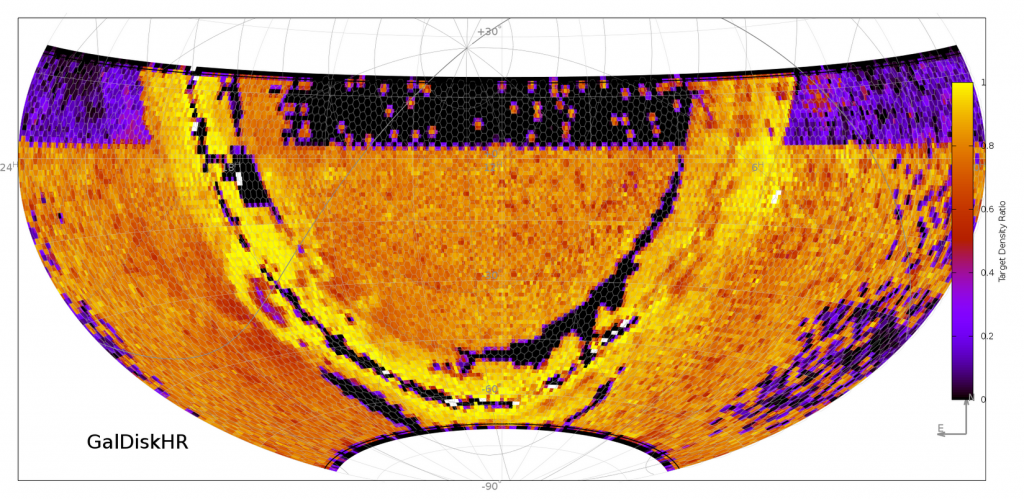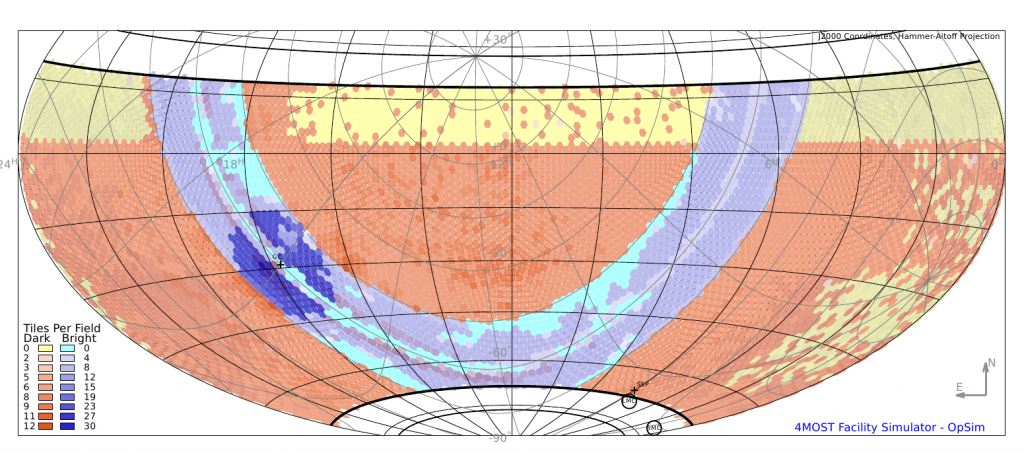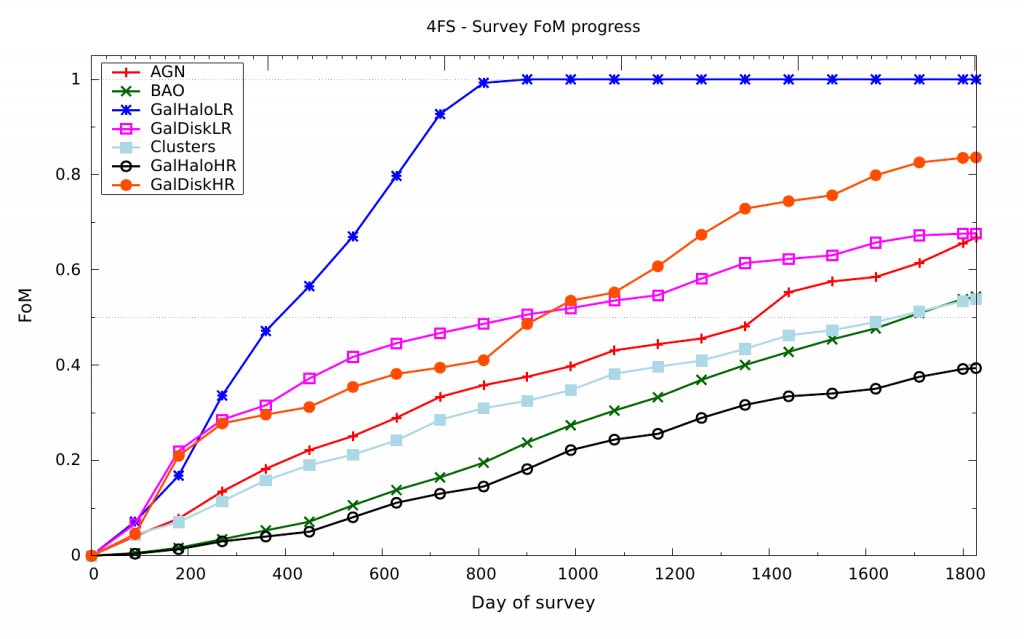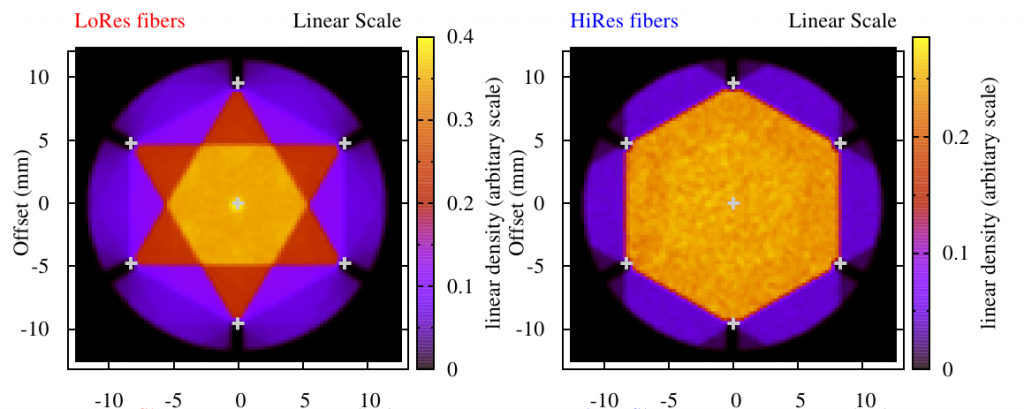Survey Simulations
In parallel observing mode, the target catalogues of all Participating Surveys will be merged, and a joint survey plan to observe all targets will be developed through an iterative process. The Operations System provides the tools to estimate the feasibility and likely success of 4MOST observations and runs the simulations necessary to create the joint survey plan.
Survey Strategy Considerations

A map of the fraction of targets from one of the Consortium Surveys that are predicted to have been successfully observed by the end of the 5-year 4MOST operations.
To ensure that science surveys having very different observational requirements can be observed simultaneously, a few constraints are imposed on the targets and the observing strategy:
The sky is divided into regions that will be observed as much as possible in similar observing conditions (sky brightness, seeing) such that targets in the appropriate magnitude range can be chosen. Bright time will be primarily devoted to the area dominated by stellar targets (i.e. the Galactic plane and bulge, plus the Magellanic Clouds), while dark/grey time will be devoted to the extragalactic sky. A large fraction of the sky in the range -70° < Dec < +5° will be observed by 4MOST.
The 4MOST survey footprint will be visited multiple times, with an expectation that each field will be observed for a number of different exposures (or "tiles"). The length of these exposures (varying between approximately 10 and 30 min) will be optimized based on the required exposure times of the targets. On average, each part of the 4MOST survey footprint will be observed for a total of 1-2 h. Some fields with high target densities will receive many more tiles. After each exposure, any fibre previously placed on a target that has received sufficient exposure time to reach its signal-to-noise requirement will be moved to a new target. Targets that need more exposure time will be assigned a fibre in subsequent tiles until the required time has been reached.

Predicted sky coverage of the 4MOST sky survey after 5 years of operations, illustrating the number of 20 min tiles delivered per field.
4MOST Facility Simulator
To demonstrate the feasibility of the above operations concept, and to prepare for the actual observations, a detailed simulator has been developed. The 4MOST Facility Simulator (4FS) consists of two main components: the 4FS Exposure Time Calculator and the 4FS Operations Simulator. The 4FS Web Interface provides online access to both of these components, as well as to the 4FS User Manual.
4FS Exposure Time Calculator
The 4FS Exposure Time Calculator (4FS_ETC) is a software tool used to fold large numbers of spectral templates through the system response of the 4MOST facility taking account of the range of possible atmospheric conditions. The 4FS_ETC derives its description of the 4MOST instrument response using outputs of the full instrument simulator TOAD. More details are provided by this description of the 4FS_ETC.
The 4FS_ETC is used to estimate the exposure time that will be required (under a range of observing conditions) to obtain spectra of science targets that have a sufficiently high signal-to-noise ratio to satisfy the specific data quality requirements associated with each target. The 4FS_ETC is coded in such a way as to allow rapid bulk processing of a large number of spectral templates through a large parameter space of observing conditions. By design, the 4FS_ETC provides fully consistent results when compared to the single-object online ESO 4MOST ETC.
4FS Operations Simulator
The 4FS Operations Simulator (4FS_OpSim) is a software tool used to simulate the progress of the 5-year 4MOST survey. The 4FS_OpSim is used to plan, optimise and verify many aspects of operations planning. The 4FS_OpSim is also used as a system engineering tool, to examine the impact of instrument design choices on science survey outcomes. The 4FS_OpSim contains a detailed parameterised model of the 4MOST facility, including representations of the instrument focal plane, the various constraints/limitations, and a statistical model of the operating environment (e.g. the long-term atmospheric/environmental conditions at Paranal). Where possible, the 4FS_OpSim uses prototype versions of the various algorithms that will be used to operate the real 4MOST survey, e.g fibre-to-target assignment, survey strategy, survey scheduling and progress balancing/feedback algorithms. The 4FS_OpSim serves as the primary test-bed for development and optimisation of these algorithms and their optimal control parameters.

Progress of survey Figures-of-Merit for the seven original design reference surveys over the 5 years of the 4MOST survey.
The 4FS_OpSim takes as its main input a set of target catalogues associated with the science surveys, together with a description of how the success of each survey may be quantified, a so-called "survey Figure-of-Merit" (FoM). One "run" of the 4FS_OpSim simulates the night-time tile-to-tile operations of 4MOST over the 5-year survey duration, right down to the decision tree that results in the placement of individual fibres on individual science targets. The 4FS_OpSim outputs a large quantity of diagnostic information, both high-level and detailed. At one end of the scale, the 4FS_OpSim reports the survey FoMs that can be readily compared when adjusting, for example, the parameters describing the survey strategy. At the other extreme the 4FS_OpSim outputs very detailed information, such as catalogues describing which targets have been observed and for how long, together with detailed diagnostic information about fibre movements and usage.
Simulation Results
We show some example figures produced by the 4FS_OpSim that provide diagnostic information about survey success, fibre usage, predicted survey sky coverage and target completeness.
